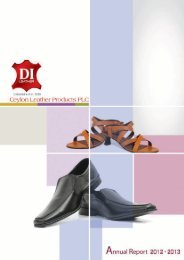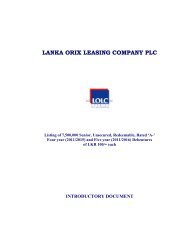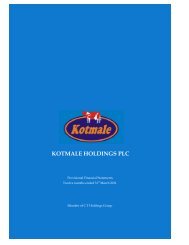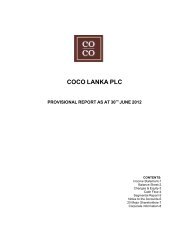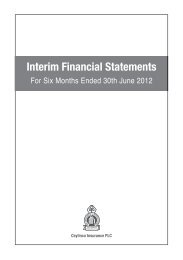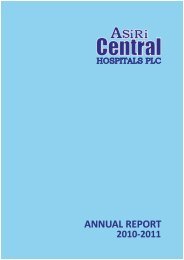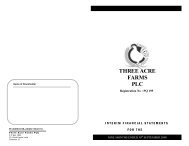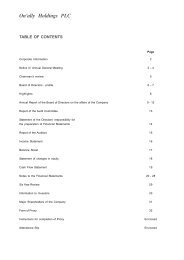Annual Report 2011 - 2012 - Colombo Stock Exchange
Annual Report 2011 - 2012 - Colombo Stock Exchange
Annual Report 2011 - 2012 - Colombo Stock Exchange
Create successful ePaper yourself
Turn your PDF publications into a flip-book with our unique Google optimized e-Paper software.
14<br />
NOTES TO THE FINANCIAL STATEMENTS Year ended 31 March <strong>2012</strong><br />
2.4.8. Property, Plant & Equipment<br />
Property, plant & equipment are stated at cost, excluding the costs of day to day servicing, less accumulated depreciation and accumulated<br />
impairment in value. Such cost includes the cost of replacing part of the plant and equipment when that cost is incurred, if the recognition<br />
criteria are met.<br />
Land and buildings are measured at fair value less depreciation on buildings and impairment charged subsequent to the date of the revaluation.<br />
Depreciation is charged to the income statement on straight-line basis.<br />
Valuations are performed every 3-5 years (or frequently enough) to ensure that the fair value of a revalued asset does not differ materially from<br />
its carrying amount.<br />
Any revaluation surplus is credited to the revaluation reserve included in the equity section of the balance sheet, except to the extent that it<br />
reverses a revaluation decrease of the same asset previously recognised in profit or loss, in which case the increase is recognised in profit or<br />
loss. A revaluation deficit is recognised in profit or loss, except that a deficit directly offsetting a previous surplus on the same asset is directly<br />
offset against the surplus in the asset revaluation reserve.<br />
An item of property, plant and equipment is derecognized upon disposal or when no future economic benefits are expected from its use or<br />
disposal. Any gain or loss arising on derecognition of the assets (calculated as the difference between the net disposal proceeds and the carrying<br />
amount of the assets) is included in the income statement in the year the asset is derecognized.<br />
The assets’ residual values, useful lives and methods of depreciation are reviewed and adjusted if appropriate, at each financial year end.<br />
2.4.9. Investment Property<br />
Investment properties are measured initially at cost, including transaction costs. The carrying amount includes the cost of replacing part of an<br />
existing investment property at the time that cost is incurred if the recognition criteria are met; and excludes the costs of day-to-day servicing<br />
of an investment property.<br />
Subsequent to initial recognition, investment properties are stated at fair value, which reflects market conditions at the reporting date. Gains<br />
or losses arising from changes in the fair values of investment properties are included in the income statement in the year in which they arise.<br />
Investment properties are derecognized when disposed or permanently withdrawn from use and no future economic benefits are expected. Any<br />
gains or losses on retirement or disposal are recognized in the income statement in the year of retirement or disposal.<br />
Transfers are made to investment property, when there is a change in use, evidenced by end of owner occupation, commencement of an<br />
operating lease to another party or ending of construction or development. Transfers are made from investment property, when there is a<br />
change in use, evidenced by commencement of owner occupation or commencement of development with a view to sale.<br />
2.4.10. Intangible Assets<br />
Intangible assets acquired separately are measured on initial recognition at cost. Following initial recognition, intangible assets are carried at<br />
cost less any accumulated amortization and any accumulated impairment losses. Internally generated intangible assets, excluding capitalized<br />
development costs, are not capitalized and expenditure is reflected in the income statement in the year in which the expenditure is incurred.<br />
Intangible assets with finite lives are amortised over the useful economic life and assessed for impairment whenever there is an indication that<br />
the intangible assets may be impaired. The amortisation period and the amortization method for intangible assets with finite useful life is<br />
reviewed at least at each financial year end. Changes in the expected useful life or the expected pattern of consumption of future economic<br />
benefits embodied in the asset is accounted for by changing the amortisation period or method, as appropriate, and treated as changes in<br />
The <strong>Colombo</strong> Pharmacy Company PLC<br />
<strong>Annual</strong> <strong>Report</strong> <strong>2011</strong> - <strong>2012</strong><br />
Notes to the Financial Statements<br />
38





